Rui Yu
FoMo4Wheat: Toward reliable crop vision foundation models with globally curated data
Sep 08, 2025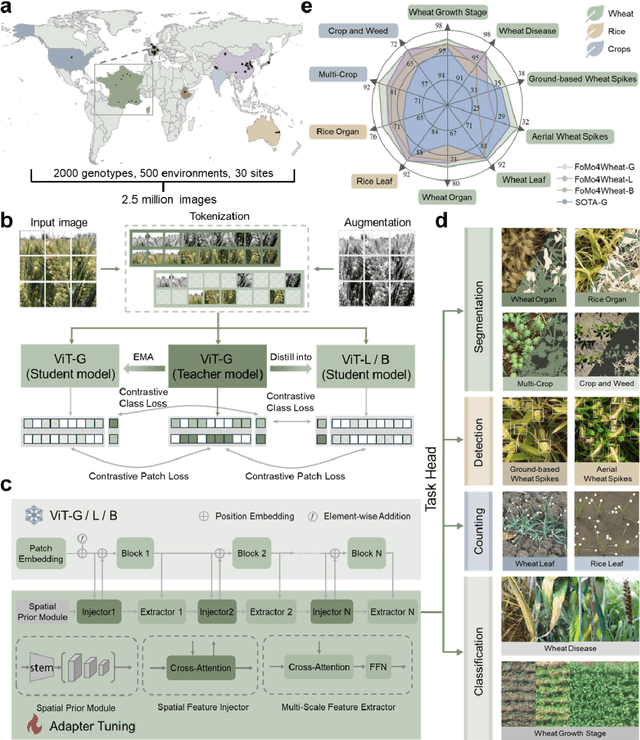
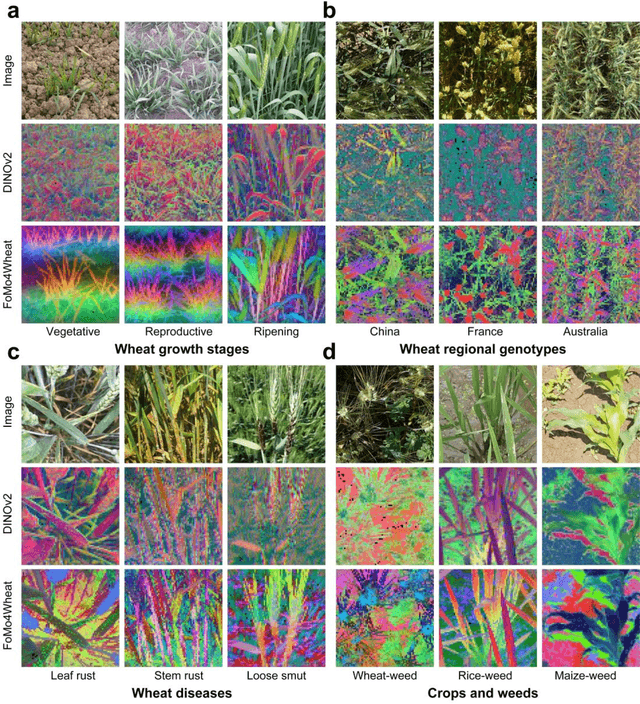
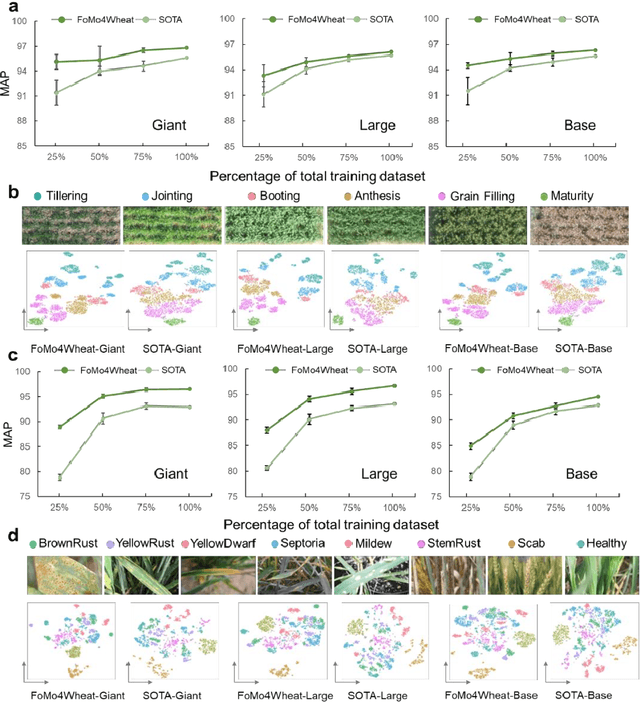
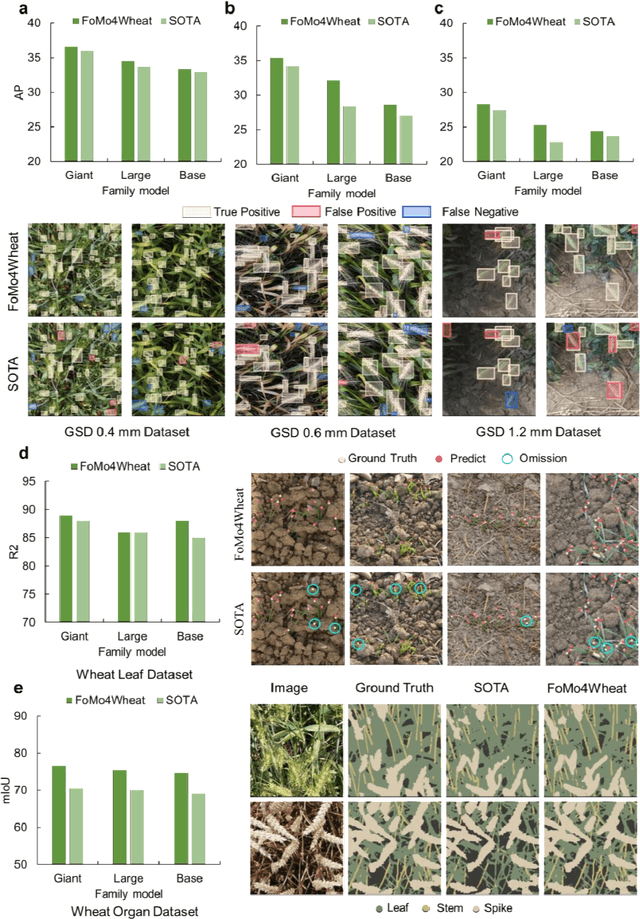
Abstract:Vision-driven field monitoring is central to digital agriculture, yet models built on general-domain pretrained backbones often fail to generalize across tasks, owing to the interaction of fine, variable canopy structures with fluctuating field conditions. We present FoMo4Wheat, one of the first crop-domain vision foundation model pretrained with self-supervision on ImAg4Wheat, the largest and most diverse wheat image dataset to date (2.5 million high-resolution images collected over a decade at 30 global sites, spanning >2,000 genotypes and >500 environmental conditions). This wheat-specific pretraining yields representations that are robust for wheat and transferable to other crops and weeds. Across ten in-field vision tasks at canopy and organ levels, FoMo4Wheat models consistently outperform state-of-the-art models pretrained on general-domain dataset. These results demonstrate the value of crop-specific foundation models for reliable in-field perception and chart a path toward a universal crop foundation model with cross-species and cross-task capabilities. FoMo4Wheat models and the ImAg4Wheat dataset are publicly available online: https://github.com/PheniX-Lab/FoMo4Wheat and https://huggingface.co/PheniX-Lab/FoMo4Wheat. The demonstration website is: https://fomo4wheat.phenix-lab.com/.
DistillDrive: End-to-End Multi-Mode Autonomous Driving Distillation by Isomorphic Hetero-Source Planning Model
Aug 07, 2025Abstract:End-to-end autonomous driving has been recently seen rapid development, exerting a profound influence on both industry and academia. However, the existing work places excessive focus on ego-vehicle status as their sole learning objectives and lacks of planning-oriented understanding, which limits the robustness of the overall decision-making prcocess. In this work, we introduce DistillDrive, an end-to-end knowledge distillation-based autonomous driving model that leverages diversified instance imitation to enhance multi-mode motion feature learning. Specifically, we employ a planning model based on structured scene representations as the teacher model, leveraging its diversified planning instances as multi-objective learning targets for the end-to-end model. Moreover, we incorporate reinforcement learning to enhance the optimization of state-to-decision mappings, while utilizing generative modeling to construct planning-oriented instances, fostering intricate interactions within the latent space. We validate our model on the nuScenes and NAVSIM datasets, achieving a 50\% reduction in collision rate and a 3-point improvement in closed-loop performance compared to the baseline model. Code and model are publicly available at https://github.com/YuruiAI/DistillDrive
Reward Models in Deep Reinforcement Learning: A Survey
Jun 18, 2025Abstract:In reinforcement learning (RL), agents continually interact with the environment and use the feedback to refine their behavior. To guide policy optimization, reward models are introduced as proxies of the desired objectives, such that when the agent maximizes the accumulated reward, it also fulfills the task designer's intentions. Recently, significant attention from both academic and industrial researchers has focused on developing reward models that not only align closely with the true objectives but also facilitate policy optimization. In this survey, we provide a comprehensive review of reward modeling techniques within the deep RL literature. We begin by outlining the background and preliminaries in reward modeling. Next, we present an overview of recent reward modeling approaches, categorizing them based on the source, the mechanism, and the learning paradigm. Building on this understanding, we discuss various applications of these reward modeling techniques and review methods for evaluating reward models. Finally, we conclude by highlighting promising research directions in reward modeling. Altogether, this survey includes both established and emerging methods, filling the vacancy of a systematic review of reward models in current literature.
JailBound: Jailbreaking Internal Safety Boundaries of Vision-Language Models
May 26, 2025Abstract:Vision-Language Models (VLMs) exhibit impressive performance, yet the integration of powerful vision encoders has significantly broadened their attack surface, rendering them increasingly susceptible to jailbreak attacks. However, lacking well-defined attack objectives, existing jailbreak methods often struggle with gradient-based strategies prone to local optima and lacking precise directional guidance, and typically decouple visual and textual modalities, thereby limiting their effectiveness by neglecting crucial cross-modal interactions. Inspired by the Eliciting Latent Knowledge (ELK) framework, we posit that VLMs encode safety-relevant information within their internal fusion-layer representations, revealing an implicit safety decision boundary in the latent space. This motivates exploiting boundary to steer model behavior. Accordingly, we propose JailBound, a novel latent space jailbreak framework comprising two stages: (1) Safety Boundary Probing, which addresses the guidance issue by approximating decision boundary within fusion layer's latent space, thereby identifying optimal perturbation directions towards the target region; and (2) Safety Boundary Crossing, which overcomes the limitations of decoupled approaches by jointly optimizing adversarial perturbations across both image and text inputs. This latter stage employs an innovative mechanism to steer the model's internal state towards policy-violating outputs while maintaining cross-modal semantic consistency. Extensive experiments on six diverse VLMs demonstrate JailBound's efficacy, achieves 94.32% white-box and 67.28% black-box attack success averagely, which are 6.17% and 21.13% higher than SOTA methods, respectively. Our findings expose a overlooked safety risk in VLMs and highlight the urgent need for more robust defenses. Warning: This paper contains potentially sensitive, harmful and offensive content.
Computer-Aided Layout Generation for Building Design: A Review
Apr 13, 2025Abstract:Generating realistic building layouts for automatic building design has been studied in both the computer vision and architecture domains. Traditional approaches from the architecture domain, which are based on optimization techniques or heuristic design guidelines, can synthesize desirable layouts, but usually require post-processing and involve human interaction in the design pipeline, making them costly and timeconsuming. The advent of deep generative models has significantly improved the fidelity and diversity of the generated architecture layouts, reducing the workload by designers and making the process much more efficient. In this paper, we conduct a comprehensive review of three major research topics of architecture layout design and generation: floorplan layout generation, scene layout synthesis, and generation of some other formats of building layouts. For each topic, we present an overview of the leading paradigms, categorized either by research domains (architecture or machine learning) or by user input conditions or constraints. We then introduce the commonly-adopted benchmark datasets that are used to verify the effectiveness of the methods, as well as the corresponding evaluation metrics. Finally, we identify the well-solved problems and limitations of existing approaches, then propose new perspectives as promising directions for future research in this important research area. A project associated with this survey to maintain the resources is available at awesome-building-layout-generation.
Unimodal-driven Distillation in Multimodal Emotion Recognition with Dynamic Fusion
Mar 31, 2025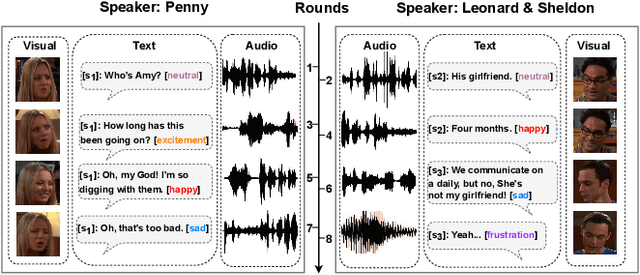
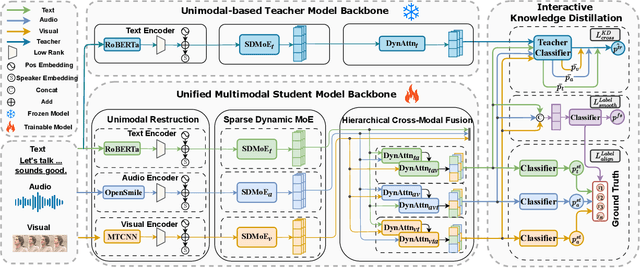
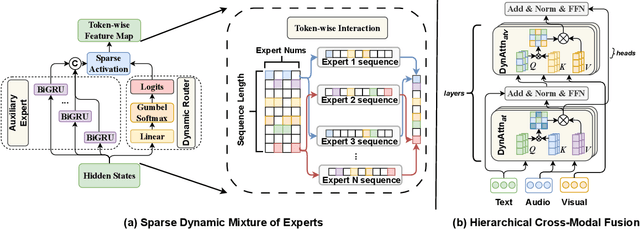
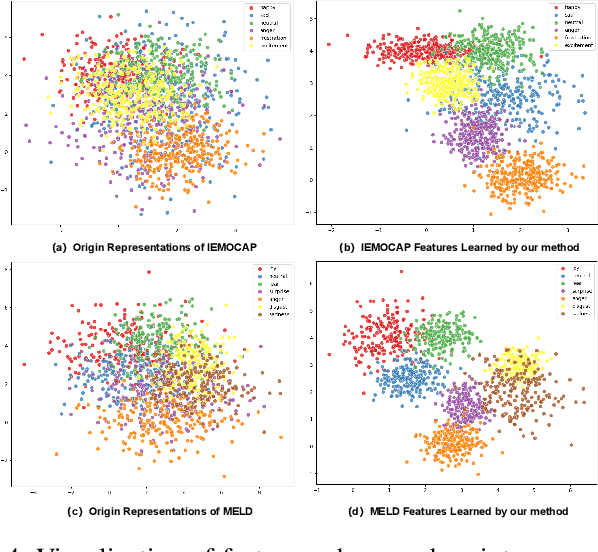
Abstract:Multimodal Emotion Recognition in Conversations (MERC) identifies emotional states across text, audio and video, which is essential for intelligent dialogue systems and opinion analysis. Existing methods emphasize heterogeneous modal fusion directly for cross-modal integration, but often suffer from disorientation in multimodal learning due to modal heterogeneity and lack of instructive guidance. In this work, we propose SUMMER, a novel heterogeneous multimodal integration framework leveraging Mixture of Experts with Hierarchical Cross-modal Fusion and Interactive Knowledge Distillation. Key components include a Sparse Dynamic Mixture of Experts (SDMoE) for capturing dynamic token-wise interactions, a Hierarchical Cross-Modal Fusion (HCMF) for effective fusion of heterogeneous modalities, and Interactive Knowledge Distillation (IKD), which uses a pre-trained unimodal teacher to guide multimodal fusion in latent and logit spaces. Experiments on IEMOCAP and MELD show SUMMER outperforms state-of-the-art methods, particularly in recognizing minority and semantically similar emotions.
PlanarSplatting: Accurate Planar Surface Reconstruction in 3 Minutes
Dec 04, 2024
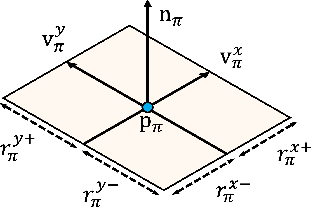

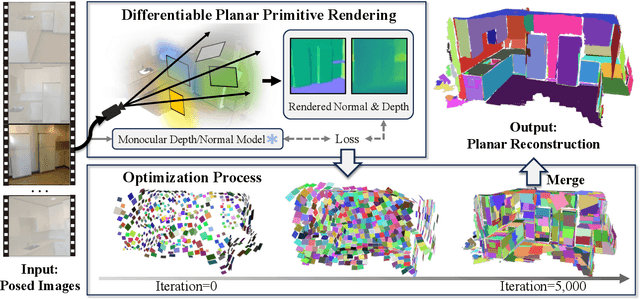
Abstract:This paper presents PlanarSplatting, an ultra-fast and accurate surface reconstruction approach for multiview indoor images. We take the 3D planes as the main objective due to their compactness and structural expressiveness in indoor scenes, and develop an explicit optimization framework that learns to fit the expected surface of indoor scenes by splatting the 3D planes into 2.5D depth and normal maps. As our PlanarSplatting operates directly on the 3D plane primitives, it eliminates the dependencies on 2D/3D plane detection and plane matching and tracking for planar surface reconstruction. Furthermore, the essential merits of plane-based representation plus CUDA-based implementation of planar splatting functions, PlanarSplatting reconstructs an indoor scene in 3 minutes while having significantly better geometric accuracy. Thanks to our ultra-fast reconstruction speed, the largest quantitative evaluation on the ScanNet and ScanNet++ datasets over hundreds of scenes clearly demonstrated the advantages of our method. We believe that our accurate and ultrafast planar surface reconstruction method will be applied in the structured data curation for surface reconstruction in the future. The code of our CUDA implementation will be publicly available. Project page: https://icetttb.github.io/PlanarSplatting/
Unleashing the Potential of Mamba: Boosting a LiDAR 3D Sparse Detector by Using Cross-Model Knowledge Distillation
Sep 17, 2024



Abstract:The LiDAR-based 3D object detector that strikes a balance between accuracy and speed is crucial for achieving real-time perception in autonomous driving and robotic navigation systems. To enhance the accuracy of point cloud detection, integrating global context for visual understanding improves the point clouds ability to grasp overall spatial information. However, many existing LiDAR detection models depend on intricate feature transformation and extraction processes, leading to poor real-time performance and high resource consumption, which limits their practical effectiveness. In this work, we propose a Faster LiDAR 3D object detection framework, called FASD, which implements heterogeneous model distillation by adaptively uniform cross-model voxel features. We aim to distill the transformer's capacity for high-performance sequence modeling into Mamba models with low FLOPs, achieving a significant improvement in accuracy through knowledge transfer. Specifically, Dynamic Voxel Group and Adaptive Attention strategies are integrated into the sparse backbone, creating a robust teacher model with scale-adaptive attention for effective global visual context modeling. Following feature alignment with the Adapter, we transfer knowledge from the Transformer to the Mamba through latent space feature supervision and span-head distillation, resulting in improved performance and an efficient student model. We evaluated the framework on the Waymo and nuScenes datasets, achieving a 4x reduction in resource consumption and a 1-2\% performance improvement over the current SoTA methods.
Future Does Matter: Boosting 3D Object Detection with Temporal Motion Estimation in Point Cloud Sequences
Sep 06, 2024



Abstract:Accurate and robust LiDAR 3D object detection is essential for comprehensive scene understanding in autonomous driving. Despite its importance, LiDAR detection performance is limited by inherent constraints of point cloud data, particularly under conditions of extended distances and occlusions. Recently, temporal aggregation has been proven to significantly enhance detection accuracy by fusing multi-frame viewpoint information and enriching the spatial representation of objects. In this work, we introduce a novel LiDAR 3D object detection framework, namely LiSTM, to facilitate spatial-temporal feature learning with cross-frame motion forecasting information. We aim to improve the spatial-temporal interpretation capabilities of the LiDAR detector by incorporating a dynamic prior, generated from a non-learnable motion estimation model. Specifically, Motion-Guided Feature Aggregation (MGFA) is proposed to utilize the object trajectory from previous and future motion states to model spatial-temporal correlations into gaussian heatmap over a driving sequence. This motion-based heatmap then guides the temporal feature fusion, enriching the proposed object features. Moreover, we design a Dual Correlation Weighting Module (DCWM) that effectively facilitates the interaction between past and prospective frames through scene- and channel-wise feature abstraction. In the end, a cascade cross-attention-based decoder is employed to refine the 3D prediction. We have conducted experiments on the Waymo and nuScenes datasets to demonstrate that the proposed framework achieves superior 3D detection performance with effective spatial-temporal feature learning.
Attention-Guided Perturbation for Unsupervised Image Anomaly Detection
Aug 14, 2024Abstract:Reconstruction-based methods have significantly advanced modern unsupervised anomaly detection. However, the strong capacity of neural networks often violates the underlying assumptions by reconstructing abnormal samples well. To alleviate this issue, we present a simple yet effective reconstruction framework named Attention-Guided Pertuation Network (AGPNet), which learns to add perturbation noise with an attention mask, for accurate unsupervised anomaly detection. Specifically, it consists of two branches, \ie, a plain reconstruction branch and an auxiliary attention-based perturbation branch. The reconstruction branch is simply a plain reconstruction network that learns to reconstruct normal samples, while the auxiliary branch aims to produce attention masks to guide the noise perturbation process for normal samples from easy to hard. By doing so, we are expecting to synthesize hard yet more informative anomalies for training, which enable the reconstruction branch to learn important inherent normal patterns both comprehensively and efficiently. Extensive experiments are conducted on three popular benchmarks covering MVTec-AD, VisA, and MVTec-3D, and show that our framework obtains leading anomaly detection performance under various setups including few-shot, one-class, and multi-class setups.
 Add to Chrome
Add to Chrome Add to Firefox
Add to Firefox Add to Edge
Add to Edge